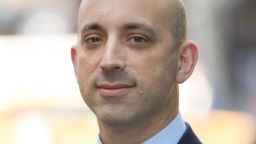Editor’s Note: Jonathan A. Greenblatt is CEO and National Director of the Anti-Defamation League. The views expressed in this commentary are his own. View more opinion on CNN.
Six months to the day of the shooting at the Tree of Life synagogue in Pittsburgh, an armed gunman walked into the sacred confines of a Chabad synagogue near San Diego and opened fire, killing one and injuring several others. This was history repeating itself before it had even become history.
We’ve since learned that the shooter’s alleged motive for carrying out this heinous attack on a house of worship was nearly identical to that of the Tree of Life killer: He saw Jews as a threat to the white race, who therefore needed to be eradicated.

As if we needed another reminder, the Poway shooting should serve as a warning of the reality and virulence of anti-Semitism. It must also serve as a call to action for us to deal, once and for all, with hate. Jewish people and those of all faiths should not have to live in fear of going to their houses of worship.
Pittsburgh should have been a wake-up call for our political leaders regarding the dangers of rising anti-Semitism. And yet, instead, it became a political football.
Instead of any concerted effort to root out the causes of anti-Semitism in society, we saw very little in the way of concrete action. There were initial expressions of concern and solidarity, but soon the incident faded from public consciousness. And then we had moved on to another controversy involving anti-Semitism from a member of Congress on the political left, which turned into more finger-pointing until the congresswomen eventually issued an apology.
The immediate question before our leaders is how to address hate crimes – and what we, as a society, can do to help make people safer.
This applies to every faith group: Jews, Christians and Muslims have all been attacked in their most sacred spaces in recent years. We can no longer just throw up our hands every time there’s another violent anti-Semitic attack in America, and we can no longer impassively witness the smaller slings and arrows of creeping anti-Semitism, whether it’s a cartoon in The New York Times or a swastika on a billboard, without responding.
One act of anti-Semitism can lead to another – and can also metastasize into attacks on other faith communities.
So, in the immediate aftermath of Poway, I would suggest there are a number of things we can and must do now before we lose the momentum.
Most importantly: As we look at our country, we must recognize that the threat of domestic terrorism has clearly changed. That means we need to shift our priorities to combat the rising threat of white supremacist violence. There is a through-line from Charlottesville to Pittsburgh to Christchurch and now Poway. We need to articulate the issue in clear and simple terms: White supremacy is a global terror threat.
This abhorrent ideology is steeped in hate and violence. And, as we saw in New Zealand, it honors no borders and respects no faith. Therefore, our authorities need to bring the same level of energy and intensity that they brought to the fight against radical Islamist terror to the fight against white supremacist terror.
Second, it is long overdue for the White House to call out this threat by name and fully engage the capabilities of the Department of Homeland Security, as well as the FBI and other law enforcement agencies. They need to devote more resources to analyzing domestic terrorism threats – not less, as they have done thus far.
The administration has diverted countering violent extremism grants toward Islamic extremism, rather than focusing on far right domestic terrorists, who now pose an equally, if not more, dangerous threat.
Our counterterrorism agencies need to recognize that American white supremacists, as well as those abroad, are adopting the same tactics and strategies long employed by groups such as ISIS and Al Qaeda, including optimizing their attacks for social media, coordinating plans using encrypted services and radicalizing lone wolves to carry out operations.
More broadly, we have to deal with the developing climate of anti-Semitism and its legitimization in recent years. Some of this comes from the right and some comes from the left; in the latter case partly under the guise of criticism of Israel, but not only so. The important element here is for those on each side of the political spectrum to stand up against instances of anti-Semitism that come not only from the other side, but from their own as well.
Finally, we need social media and technology companies to work together with policymakers to fill in the gaps in addressing the impact of technological advances that are helping haters spread their ideas online and on social media. In recent months, Facebook, Twitter and other social media sites have taken steps to remove extremist content and users from their platforms – a good, albeit long overdue first step.
One thing is clear: It will take a comprehensive approach to fight anti-Semitism – and to put the lid back on the sewers of intolerance that are plaguing our society.


